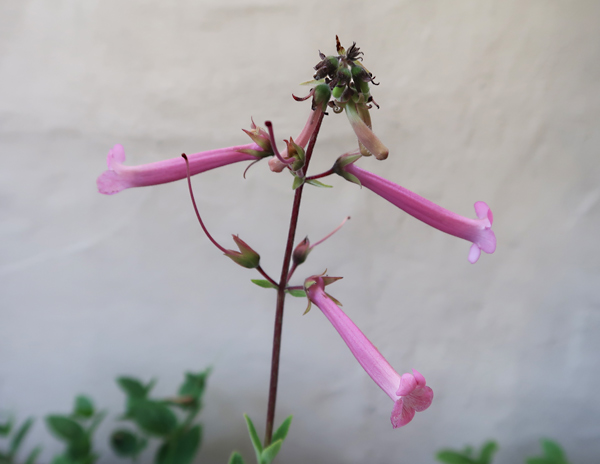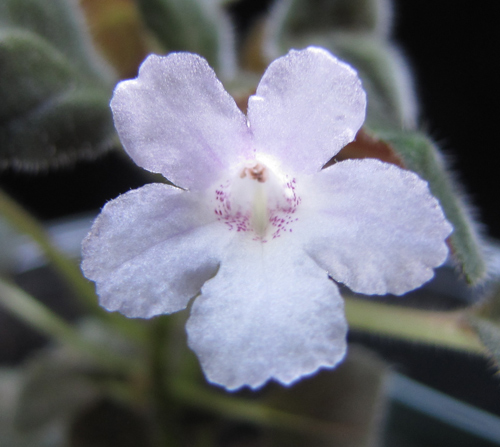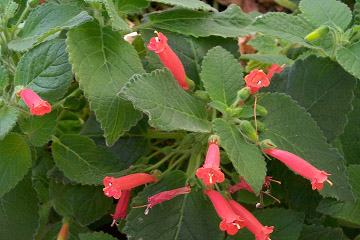Sinningia Corytholoma-clade species hybridization chart
The following table shows the primary hybrids (species x species)
between those species in the
Corytholoma clade
most frequently used in hybridizing.
This is not a complete list, but it should provide
some guidance about what things have already been done.
Notes for each species provide additional information
about secondary crosses and other potentially useful information.
There is a lot more empty space in this table than in the
corresponding Dircaea table,
which means that there is a lot more opportunity
for hybridizers.
While the plants of this clade are not in general as showy,
especially in regard to flower size and foliage,
there are some new species like
S. araneosa and
S. stapelioides and
S. nordestina, plus
S. bragae,
which should offer good material for crosses.
Both S. aghensis and
S. bragae
should be crossed with the micro species,
since the molecular data indicate that the micros
are closely related to
S. aghensis and possibly to
S. bragae as well.
Prospects are not so bright for getting anything good from
S. richii.
It is way out on the very edge of the clade
(see the table),
so at best any cross would be sterile.
The same may well be true of
S. barbata.
That being said, it should be mentioned that tetraploidy
provides opportunities that strict genetics would seem
to preclude.
Crosses between the aghensis/miniatures group and other species in the clade
or in the Dircaea clade have proved to be sterile, but fertile
tetraploids of those hybrids have appeared in a number of cases.
Such tetraploidy may be available in the case of other Corytholoma-clade hybrids too.
In the Dircaea clade, it is quite likely that all primary
crosses -- in fact, all crosses whatsoever -- will be fertile.
The species in that clade all seem quite closely related.
Crosses involving the species most distantly related to the rest
(namely S. reitzii)
have all been fertile, in my experience,
so there is little reason to expect any such crosses to be sterile.
Things are different in the Corytholoma clade,
which includes some species (most notably
S. richii)
that are only distantly related to the rest.
Nonetheless, crossing experiments over the years
have yielded some good results.
What appears to be the case is that hybrids among
the species in the
Corytholoma core group
are at least somewhat fertile.
Hybrids in the
aghensis+miniature group
are or may be weakly fertile.
Outside of those clusters, it is unlikely that crosses will be fertile.
Some three-species crosses have been done in the Corytholoma core group.
See the S. 'Apricot Bouquet' page for an example.
In the 1960s, Carl Clayberg
did a set of crossing experiments between species of
Sinningia
(and Rechsteineria).
He included four members of the Corytholoma clade:
S. aggregata,
S. tubiflora,
S. warmingii, and
S. incarnata.
For the complete results, see the crossing chart.
For our purposes here, it suffices to note that he showed that all six possible
combinations (considering A x B and B x A to be the same) produced fertile hybrid plants.
Key to the table:
| 06 | one of the Clayberg 6 (fertile hybrid) |
| F | fertile hybrid |
| X | hybrid of unknown fertility |
| s | sterile hybrid |
| w | weak plant that did not bloom |
Corytholoma Crossing Table
Hover mouse pointer over abbreviation in top or bottom line to see species name.
As we did on the early-crossing page, we can rearrange
the order of species in the table to group species which have been
shown to form fertile hybrids with one another.
The result is not as dramatic, but we can still see the block of about
60% of the species (down through S. nordestina) that constitute
the Corytholoma core group,
plus a smaller block in the lower right corner containing the
aghensis/miniature group.
Hover mouse pointer over abbreviation in top or bottom line to see species name.
| Species |
Abbr |
Notes |
wa |
se |
su |
am |
ag |
tu |
ar |
bz |
sm |
in |
no |
ba |
ah |
br |
he |
pu |
co |
mu |
ri |
| S. warmingii |
wm |
N |
= |
- |
- |
- |
F |
F |
- |
F |
- |
F |
- |
w |
- |
- |
- |
- |
- |
- |
- |
| S. sellovii |
sv |
N |
- |
= |
X |
- |
F |
F |
- |
- |
- |
- |
X |
- |
- |
- |
- |
- |
X |
- |
- |
| S. sulcata |
su |
N |
- |
X |
= |
X |
F |
- |
- |
- |
- |
- |
- |
- |
- |
- |
- |
- |
- |
- |
- |
| S. amambayensis |
ay |
N |
- |
- |
X |
= |
X |
- |
- |
- |
- |
- |
F |
- |
- |
- |
- |
- |
- |
- |
- |
| S. aggregata |
ag |
N |
F |
F |
F |
X |
= |
F |
- |
F |
- |
F |
- |
- |
- |
- |
- |
- |
s |
- |
s |
| S. tubiflora |
tu |
- |
F |
F |
- |
- |
F |
= |
F |
- |
- |
F |
- |
- |
- |
- |
- |
- |
- |
- |
- |
| S. araneosa |
ao |
- |
- |
- |
- |
- |
- |
F |
= |
- |
- |
- |
X |
- |
- |
- |
- |
- |
- |
- |
- |
| S. brasiliensis |
bz |
- |
F |
- |
- |
- |
F |
- |
- |
= |
- |
F |
- |
- |
X |
- |
- |
- |
- |
- |
- |
| S. sceptrum |
sm |
- |
- |
- |
- |
- |
- |
- |
- |
- |
= |
- |
- |
- |
- |
- |
- |
- |
- |
- |
- |
| S. incarnata |
ic |
- |
F |
- |
- |
- |
F |
F |
- |
F |
- |
= |
- |
- |
- |
- |
- |
- |
- |
- |
s |
| S. nordestina |
ne |
- |
- |
X |
- |
F |
- |
- |
X |
- |
- |
- |
= |
- |
- |
- |
- |
- |
X |
- |
- |
| S. barbata |
bt |
N |
w |
- |
- |
- |
- |
- |
- |
- |
- |
- |
- |
= |
- |
- |
- |
- |
- |
- |
X |
| S. aghensis |
ah |
- |
- |
- |
- |
- |
- |
- |
- |
X |
- |
- |
- |
- |
= |
w |
- |
F |
- |
- |
- |
| S. bragae |
ib |
N |
- |
- |
- |
- |
- |
- |
- |
- |
- |
- |
- |
- |
w |
= |
- |
F |
- |
X |
- |
| S. helioana |
st |
- |
- |
- |
- |
- |
- |
- |
- |
- |
- |
- |
- |
- |
- |
- |
= |
X |
- |
- |
- |
| S. pusilla |
pu |
N |
- |
- |
- |
- |
- |
- |
- |
- |
- |
- |
- |
- |
F |
F |
X |
= |
F |
F |
- |
| S. concinna |
ci |
- |
- |
X |
- |
- |
s |
- |
- |
- |
- |
- |
- |
- |
- |
- |
- |
F |
= |
F |
- |
| S. muscicola |
rp |
N |
- |
- |
- |
- |
- |
- |
- |
- |
- |
- |
- |
- |
- |
X |
- |
F |
F |
= |
- |
| S. richii |
rc |
N |
- |
- |
- |
- |
s |
- |
- |
- |
- |
s |
- |
X |
- |
- |
- |
- |
- |
- |
= |
| Species |
Abbr |
Notes |
wa |
se |
su |
am |
ag |
tu |
ar |
bz |
sm |
in |
no |
ba |
ah |
br |
he |
pu |
co |
mu |
ri |
Notes on primary hybrids
|
Sinningia aggregata x incarnata yielded a fertile hybrid
in Clayberg's experiments.
Sinningia aggregata x richii yielded a sterile hybrid
in Clayberg's experiments.
Sinningia aggregata x sellovii was done by Leong Tuck
Lock of Malaysia, who reports that he has selfed some of the flowers.
See a picture.
Sinningia aggregata x sulcata: Ruth Coulson had a plant
of this hybrid in the 1980s, and reports that it is/was fertile.
The two-tone yellow/pink flower sounds similar to the amambayensis x sulcata flower
mentioned below.
John Boggan, on Gesneriphiles, wrote that
S. aggregata and
S. sulcata were
among the ancestors of the hybrid S. 'Krezdorn Yellow'.
Sinningia aggregata x tubiflora yielded a fertile hybrid
in Clayberg's experiments.
Sinningia aggregata x warmingii yielded a fertile hybrid
in Clayberg's experiments.
Sinningia aghensis x brasiliensis yielded a hybrid
of unknown fertility according to Wiehler and Chautems.
Sinningia aghensis x bragae: Dave Zaitlin made
this cross, and he and I sowed the seed and got seedlings.
However, they remained small and eventually did not come out of dormancy.
This is may be evidence that the two species are not as closely related as they
appear to be.
Sinningia amambayensis x nordestina was created by Alan LaVergne.
The hybrid is fertile, and F2 seedlings have been obtained.
See the discussion on the S. amambayensis page.
Sinningia amambayensis x sulcata was created by Alan
LaVergne with pollen from Jon Dixon's S. sulcata and has bloomed.
It is unclear at this time [October 2008] whether the hybrid is fertile.
See the discussion on the S. amambayensis page.
Sinningia nordestina x araneosa was created by Alan LaVergne.
This hybrid has its own page.
Jon Lindstrom has done the cross
Sinningia araneosa x tubiflora
and reports that it is fertile.
It now has its own page.
Sinningia barbata x warmingii yielded a weak plant
which never bloomed in Clayberg's experiments.
Sinningia brasiliensis x incarnata yielded a fertile hybrid
according to Wiehler and Chautems.
Sinningia brasiliensis x warmingii yielded a fertile hybrid
according to Wiehler and Chautems.
Sinningia concinna x pusilla
was apparently created more than once in the 1960s.
Carl Clayberg crossed it with Sinningia pusilla to get
Sinningia'Bright Eyes' in 1964, and
Lyndon Lyon registered the primary hybrid as
Sinningia 'Wood Nymph' in 1966.
See also the miniatures page.
According to Peter Shalit,
"the F1 ('Wood Nymph') is only weakly fertile and cannot be selfed.
Carl Clayberg got seed by applying pollen from
Sinningia pusilla and ultimately bred
Sinningia 'Bright Eyes'.
But I would call the original species cross weakly fertile."
Sinningia concinna x muscicola was created by Jim Steuerlein,
and given the name "Li'l Georgie".
He reports that the F1 is fertile and that he has blooming plants of the F2 generation.
Sinningia concinna x sellovii was created by Dave Zaitlin,
and given the name "Deep Purple Dreaming".
See its page.
|

|
Sinningia incarnata x tubiflora yielded a fertile hybrid
in Clayberg's experiments.
Ruth Coulson reports that she has this hybrid (labelled as tubiflora x incarnata)
and that it has pink flowers of the tubiflora shape, but unscented.
I have a plant from seed labeled tubiflora x incarnata F2.
It's not clear whether that means the seed was F2 or the parent plant was.
In any case, the flower is scented.
The picture shows flowers of this plant.
See more pictures here.
|
|
Sinningia incarnata x richii yielded a sterile hybrid
in Clayberg's experiments.
Sinningia incarnata x warmingii yielded a fertile hybrid
in Clayberg's experiments.
Wu Jui-Jung of Taiwan did the cross
Sinningia pusilla 'White Sprite' x aghensis.
For a picture and some description, see
this page.
Since Mr. Wu has back-crossed this hybrid to S. pusilla,
we can infer that it is fertile.
Keith Hussen of Canada did the cross
Sinningia pusilla 'White Sprite' x muscicola.
Jon Lindstrom did
Sinningia pusilla 'White Sprite' x bragae,
and has crossed it with
S. insularis
and S. pusilla,
so it is obviously fertile.
He has named this plant Sinningia 'Arkansas Royalty'.
Vincent Parsons did Sinningia muscicola x bragae
in 2007, and the resulting plant had flowerbuds in January 2009.
Sinningia pusilla x helioana was created by
Dale Martens, using pollen from Karyn Cichocki,
and named 'Heartland's Flashlight'.
Mr. Wu of Taiwan has crossed Sinningia helioana
with the "Itaoca" form of Sinningia pusilla
and named the resulting hybrid
'Jung's Taro Smoothie'.
John Beaulieu did the cross Sinningia nordestina x sellovii and
got flowers -- as far as I know, the first S. nordestina hybrid to bloom.
Sinningia richii x warmingii yielded a sterile hybrid
in Clayberg's experiments.
The cross Sinningia sellovii x sulcata: Ruth Coulson had
this and reports that its flowers were pink with yellow lobes; the latter trait
appears to be characteristic of S. sulcata hybrids.
The cross Sinningia sellovii x tubiflora has been done by Dave Zaitlin.
It is fertile.
It was also done by Jon Lindstrom.
According to its publication in the 2011 Q2 issue of Gesneriads, he made the cross
in May 2003 and it flowered in May 2004.
A picture shows a shrubby plant with numerous pendant pink flowers.
Jon named it S. 'Arkansas Bells'.
S. sellovii x tubiflora goes back a long way.
Seed from this cross was offered in the (defunct) American Gesneria Society's seed fund listing
in 1971 (in Gesneriad Saintpaulia News).
Jon Lindstrom crossed it with
S. guttata.
Since the latter is in the Sinningia clade,
the hybrid should be sterile.
Sinningia tubiflora x warmingii yielded a fertile hybrid
in Clayberg's experiments.
This plant may or may not still be around.
A plant with the same two parents is in circulation under the name
Sinningia 'Carolyn', named after
Carolyn Ripps of the Gesneriad Society's seed fund.
The hybrid Sinningia richii x barbata was created by
Dennis Kramb of Concinnati (sorry, Cincinnati).
One species is difficult, the other is tricky.
The hybrid will have its own page soon.
The hybrid Sinningia hoehnei x richii
was created by Mr. Wu of Taiwan.
It may be the first hybrid created with
S. hoehnei.
Mr. Wu has created
several attractive hybrids.
|
Additional hybridization notes
|
Bruce Dunn, Jon Lindstrom's graduate student at University
of Arkansas, has crossed
S. piresiana (Dircaea clade) with
S. aggregata.
Sinningia amambayensis hybrids have so far looked much like
S. amambayensis.
However, because of the central position of this species
in the clade, the hybrids may well be fertile and thus provide opportunities
for further development.
Sinningia bragae:
Bill Price crossed this with S. eumorpha 'Saltão'.
Jon Lindstrom crossed this with S. conspicua, and with
his hybrid S. araneosa x tubiflora.
Sinningia barbata: Frances Batcheller crossed this
species with her hybrid S. 'Ramadeva' to get S. 'Benten'.
|

|
Sinningia pusilla has been crossed with a number
of species outside the clade.
John Boggan reports that one of his earliest crosses was
S. pusilla 'White Sprite' x
schiffneri to create S. 'Paper Moon'.
He says that Frances Batcheller had done virtually the same cross a few years
earlier (using the standard form of S. pusilla),
but didn't name it.
In this picture can be seen the schiffneri-like markings in the throat
of the corolla, which is white with just a tinge of lavender.
Corolla shape and size are roughly the same as both parents.
|


